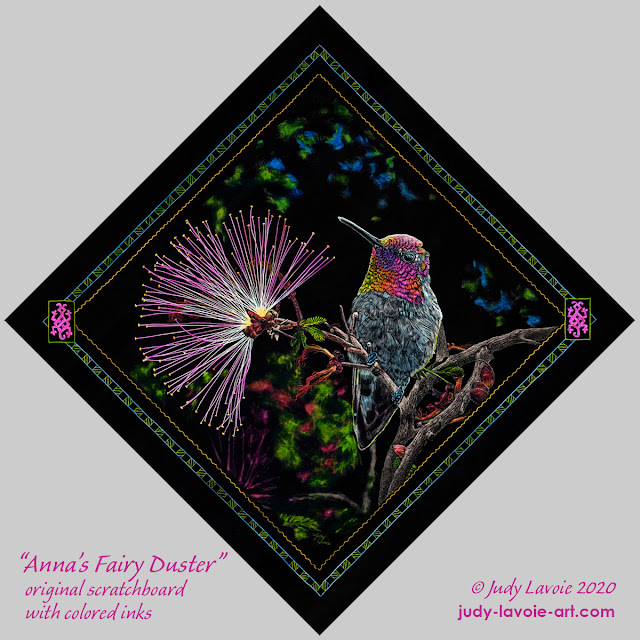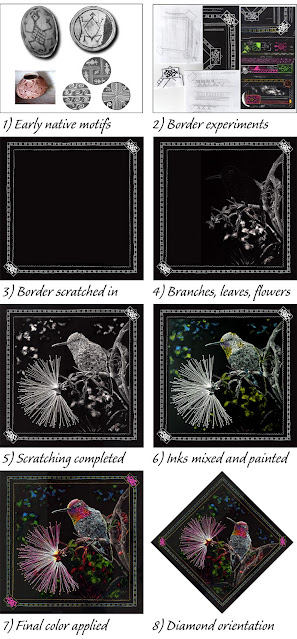
The required theme was ‘Flora and Fauna of the Desert.’ To stand out, I wanted my subject to be different from the obvious, but attractive on a t-shirt for males or females alike. I ruled out cactus, coyotes, snakes or lizards as my main subject, figuring they were too common. On a visit to Tucson in the late 1980s, the fauna which most amazed me were the variety and abundance of hummingbirds, as it is a major migratory route for these tiny birds. Many sizes, a gorgeous display of vibrant colors, huge numbers of individual birds at once. Birdwatchers Digest calls Southeastern Arizona “Hummingbird Heaven.” So I had my main subject! In researching the desert flowers which hummingbirds frequent, I discovered one called Fairy Duster, a feathery white and pink flower which would lend itself perfectly to scratchboard techniques. Now I had both flora and fauna covered… almost.
As a lifelong resident east of the Mississippi, I had neither of these subjects in my own photo references. Many of my art competitions require work from the artist’s own photos when references are used, but the scratchboard rules generally do not (perhaps because so many scratchboard artists depict exotic animals). Of course, copyrights need to be followed, so an artist must be prepared to submit written permission from the photographer if using others’ photos for reference. I browsed some two of my sources which offer reference photos to artists and didn’t see any I liked. So I turned to Instagram and started doing hashtag (#) searches. Wow, I came up with oodles of beautiful hummingbirds, including Anna’s Hummingbird, as well as Fairy Duster flowers. I was off and running.
Any medium could be used for this contest. Since this is specifically for a scratchboard exhibition, it was a no-brainer that I’d work on the black and white scratchboard surface (even though white Clapbord™ is acceptable in the ISSA). Adding color is always an option, and I have used both watercolors and inks on scratchboards. I opted for colored inks on Scratchbord™ for my entry.
I drew upon my 40+ years of experience as a graphic artist to create a unique composition. I’ve done several paintings in a square shape and rotated 45° to a diamond format, and I thought this would look terrific on a t-shirt – as well as being different from other art submitted to the contest.
Some of the past exhibition t-shirts were white, some black; either way I felt like my black scratchboard art would be better anchored if it had a border, so I started experimenting with possibilities. To tie in with the Sonora Desert theme (the exhibition is being held in Tucson AZ), I decided to adopt some motifs from Native American pottery and found some interesting samples from the Hohokam people which I could translate into a border. I did a lot of experimenting with the border design, shown in my photo. I wanted it to have a very simple primitive look in contrast with the realism of the main subject, the hummingbird and the flower. I created the final border design using Illustrator software (which I started using in 1987!!)
Also to help me stand out against the competition, I wanted to incorporate techniques not commonly used by other scratchboard artists. I’ve learned and used so many methods with decades of painting in watercolors and acrylics. In a recent scratchboard I created the look of an out of focus background by softly removing irregular spots with fiber brushes and coloring them to suggest sky, foliage and flowers. I wanted the same effect with this new painting, but leaving more of the background untouched. I’ve used Mr. Clean Magic Erasers to lift watercolor pigments from watercolor paper, so I experimented to see how a slightly dampened “Mr. Clean Magic Eraser Thin Sheet” would work to lift the black surface from the scratchboard. This is a 1/8″ dense foam sheet with no added chemicals, and it is abrasive enough to clean soap scum off your shower! I held the end of a paintbrush under the thin sheet as I rubbed away small amounts of black in a circular motion, to reveal the white clay surface below. Success – these irregular fuzzy spots were just what I was aiming for.
I scratched my entire composition before adding any color, primarily using a pointed etching tool for the bird’s many textures and for the branches, leaves, wilted flowers. For the thicker lines of the Fairy Duster flower, I scratched with a Speedball pointed scratch tool. Where I knew I’d be applying solid (but transparent) colors to the bird, I scratched away to reveal more white area than I would if not adding any color. I used Ampersand Scratchbord Inks to add my brilliant colors. I’ve always found color mixing comes naturally, and my experience painting with limited palettes of primary colors helps me to mix a variety of hues from these beautifully transparent inks. I finished the artwork with a clear satin finish, a wide wood frame and a diamond orientation for hanging.
“Anna’s Fairy Duster” took me hours and hours and hours, with more than 50% of the time devoted to researching, acquiring references, and testing my ideas and techniques on practice boards. I even did another scratchboard painting, “Ruby Throated Hummer” to practice depicting a hummingbird. It was all worth it, because I accomplished my personal goals and created a new scratchboard painting like none I’ve done to date.
 |
| © Alison Oman |
Despite all the method in my madness, “Anna’s Fairy Duster” didn’t win the t-shirt competition – but I am very proud to have been one of the top 5 finalists! The artwork chosen for the t-shirts is a magnificent scratchboard with a wide range of greyscale values and incredible feather textures, a vulture by artist Alison Oman.
My thanks to two photographers for granting me permission to use their work as reference for this painting. For the awesome close-up of the male Anna’s Hummingbird, thanks to Tammy Kokjohn (on Instagram @tammykokjohn), and to Jason Lane (Instagram @linearlane) for his perfect Fairy Duster flower.










